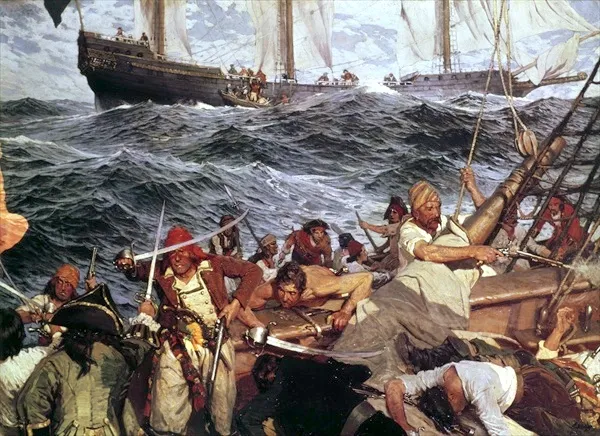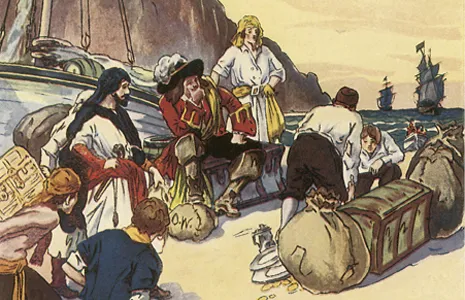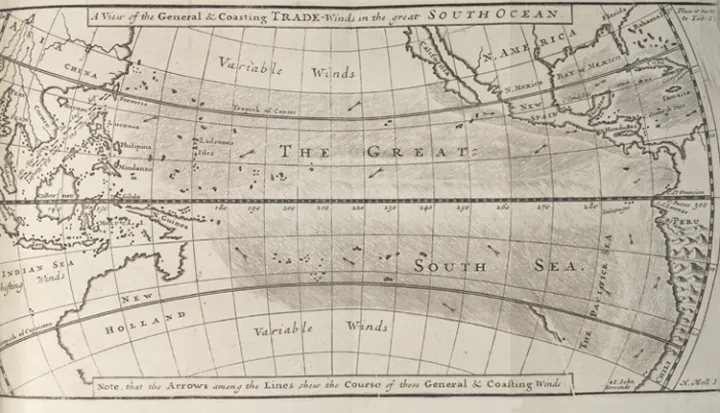William Dampier - The Pirate Who Collected Plants

Today you can just hop on a plane and be on another continent within a day's time. But a century ago the only way to get from one continent to another was by sea--and the journey took months or even years.
The ocean was the world's highway, and ships brimming with precious cargoes plied the waters. These merchant ships were tempting targets for pirates, who prowled the seas' major trade routes in search of treasure. Ever since the first oceangoing ships set sail centuries ago, pirates have been capturing ships and pillaging coastlines. In some parts of the world, piracy continues today.
Meet William Dampier: A Most Unusual Pirate
William who? Like most people, you may never have heard of this restless, curious Englishman. But William Dampier was famous in his own time and influenced some of the world's greatest scientists, explorers, and writers.
Dampier was a pirate. But he definitely wasn't your typical pirate. Like most pirates, he was motivated partly by the desire for material gain. But Dampier also had an insatiable hunger to see and describe what was then a little-known world. He journeyed around the world three times, visited places few people had ever been, and kept a detailed journal of what he saw. He published his observations in his best-selling books. And he left his own unique mark on the Golden Age of Piracy.
Piracy's Heyday
Pirates have been a scourge on the seas for thousands of years. But the heyday of pirates was the late 1600s and early 1700s. A long war in Europe had just ended. Skilled seamen in England and other countries were fed up with harsh naval life. Piracy promised freedom and wealth. And out there on the high seas were ships headed to Europe from the New World and Orient, loaded with gold, jewels, silks, and other treasures. Lured by these rewards, many able seamen ventured into the free-spirited life of piracy—including some of the most famous pirates of all time.
Flaunting flags emblazoned with skulls and crossbones, pirate ships roamed the seas in pursuit of likely prey. The ships carried fearsome men (and sometimes women) brandishing pistols and swinging swords. They did everything they could to strike terror into the hearts of their victims and to encourage ships to surrender without fighting.
Many captains wore flamboyant clothing in an effort to look as fierce and intimidating as possible. Everyone on board was dressed to kill—ready to fight to the death if necessary. All dreamed of finding a large treasure ship that would provide a luxurious retirement.
Pirate Etiquette
There's no doubt about it: pirates were cruel and greedy. They disregarded established law. But a the same time, most pirates abided by their own codes of conduct, and life aboard pirate ships was more democratic than that on naval ships at the time.
Captains were elected by popular vote and could be removed if their performances fell short. Members of the crew shared in the booty and received compensation for the loss of body parts in action- an early form of worker's compensation. This was the life that William Dampier embraced in 1674.
From Plantation to Pirate Ship
Orphaned at an early age, William Dampier whetted his appetite for the sea with several long voyages. He moved from England to Jamaica to help manage a sugar plantation, but that didn’t work out. So he went to Mexico, where he took up logging and began describing wildlife. When a hurricane destroyed his camp, Dampier joined a band of buccaneers. The pirate’s life provided Dampier with a source of income. But it also had another advantage that was just as important to him: the chance to visit and explore far-flung, little-known parts of the world. The first stop was Central and South America—including the Galapagos Islands, which would later play an important role in the development of Charles Darwin’s theories about evolution.
Observations of the New World
In between pillaging and plundering, Dampier spent every spare moment exploring the natural environment and meticulously documenting everything in sight. He was charmed by all the new animals and plants he came across. He described the hummingbird, for example, as:
…a pretty little feathered creature, no bigger than a great, over-grown wasp.;
Of the armadillo, he wrote:The head is small with a nose like a pig….on any danger…she lies stock-still like a land-turtle. And though you toss her about she will not move herself.
His passion and detailed descriptions would one day inspire scientists, writers, and British armchair travelers alike.
Long Trip Around the World
In 1679 Dampier signed up with a group of buccaneers who planned a trip to the South Seas. They ended up sailing all the way around the world. One of the places they stopped was Australia—making Dampier the first Englishman to visit that continent. He wrote:
It is not yet determined whether it is an island or a main continent, but I am certain that it joins neither Asia, Africa nor America.
The journey lasted more than 12 years. Besides his observations of animals and plants, Dampier kept careful records on winds, currents, and latitude and longitude. He stored all his notes in bamboo tubes sealed with wax. When he returned to Europe, he wrote his first book, A New Voyage Round the World. It became a best-seller, and Dampier became something of a celebrity.
After the success of his first voyage, Dampier was made captain of his own ship and invited to lead the first scientific expedition to Australia (then known as New Holland). He was fascinated by all the new animals and plants he encountered. While the ship’s artist made drawings, Dampier carefully collected and preserved plant specimens to accompany his notes. Many of these can be seen and studied at the Oxford Herbarium in England today.
Unfortunately, Dampier’s rickety ship sank on the way home—resulting in a court-martial and fine, but not an end to Dampier’s career. He wrote a second book,A Voyage to New Holland. Then in 1703 he returned to the sea, circling the globe as a privateer and capturing prizes while continuing to furiously record the natural wonders he observed.
Dampier’s third and last voyage around the globe, in 1708, was also a privateering expedition. On this trip he rescued Alexander Selkirk, a pirate who had been stranded on Juan Fernandez Island off the coast of Chile for five years.
It was also on this trip that Dampier finally fulfilled his long-held dream of seizing a Spanish treasure ship. His share of the booty—jewels, silver plate, musk, cinnamon, cloves, silks, damasks and taffetas, and Chinese porcelain—provided him with a considerable fortune that enabled him to retire.
When Dampier died a few years later, at age 63, he had spent two-thirds of his life traveling the world and covered more than 200,000 miles. That’s a lot of frequent sailing miles!
Famous People Dampier Influenced
In England, Dampier’s bestselling books about his voyages generated a new enthusiasm for travel writing. But his influence extended far beyond his homeland’s borders. Dampier’s detailed natural observations fueled the imaginations of writers and inspired the work of some of the most famous scientists and explorers of all time.
- Charles Darwin: Almost 150 years after Dampier visited the Galapagos Islands, Charles Darwin brought Dampier’s books with him on his famous voyage to South America on The Beagle—the journey that led to his formulation of the theory of evolution. Darwin called Dampier’s detailed observations “a mine” of information.
- James Cook: This legendary English explorer used Dampier’s maps of winds and currents on his journeys and urged his officers to read Dampier’s Discourse on Winds. In fact, Dampier’s maps served as the foundation for many 18th-century maps of the trade winds.
-
Daniel Defoe: The author of Robinson Crusoe based his main character on Alexander Selkirk, the Scottish privateer who Dampier helped rescue from Juan Fernandez Island. Defoe is also known by the name of Charles Johnson, who created images of several pirates, including Blackbeard, Roberts, and Bonny and Read, in his book, A General History of the Pyrates.
- Jonathan Swift: When writing Gulliver’s Travels, Swift was inspired by descriptions in his copy of Dampier’s New Voyage. He even named one character after Dampier.
By the end of his life, William Dampier was a recognized explorer and naturalist. But he was never able to shake free of his association with pirates. Perhaps that is why so many people have never heard this remarkable story of the pirate who collected plants.









